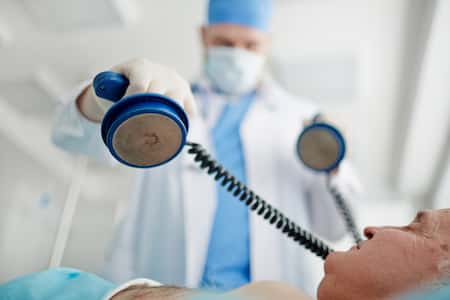
A heart attack occurs when there isnt enough blood flowing to the heart, preventing it from getting the oxygen it needs to function.This is a dangerous condition that may lead to lasting tissue damage.Severe cases may even result in death.Multiple factors can contribute to the lack of blood flow.
In most situations, there is a blockage in one or more of the arteries due to plaque build-up.This life-threatening emergency requires immediate medical attention.Read on to familiarize yourself with the common symptoms of a heart attack.What are the signs of a heart attack for men?The symptoms differ from person to person.
There are similarities and differences when it comes to genders.Most men report the following signs: Severe discomfort around the chest area.They may feel like there is something heavy applying pressure on this region.
They can also experience pain under the breastbone.Chest pain is a classic sign of a heart attack.Shifting discomfort to other areas of the body.
Aside from the chest, they might also feel a nagging ache around their back, arm, throat, or jaw area.A choking sensation.Men may feel as if they were full and experiencing indigestion.
They could start to choke like they were having a heartburn.Nausea.Men are likely to start sweating no matter the room temperature.
They could also feel dizzy while their stomach turns, making them vomit.Severe weakness.Interruption in the blood supply will make a person feel weaker, as if experiencing intense fatigue despite lack of actual physical exertion.
This could also lead to anxiety and shortness of breath.Irregular heartbeat.Checking the pulse, a person may find an unusually fast heartbeat as the body tries to compensate for the lack of blood flow.
In some cases, the heartbeat may appear uneven.What are the signs of heart attack for women?Women also report having the heart attack symptoms described above, although they are less likely to experience chest pain and a feeling of indigestion.Instead, their signs tend to be less dramatic and less obvious, so they might not always be aware of the danger that they are in.Below are some of the signs of heart attack for women: Unexplained fatigue.
They might just be going about their usual day when they suddenly feel tired, forcing them to rest for a while.Shortness of breath.They might have difficulty breathing even if they are in a perfectly fine environment.
Pain around the body.It could be a heart attack even if the pain isnt directly around the chest.Women often report pain on their back, neck, arms, shoulders, or abdomen.
Nausea and vomiting.Their stomach could turn queasy to the point that they start to vomit.Women might think they ate something bad, but the presence of the other signs on this list increases the probability that it is a heart attack.
Insomnia.Before the heart attack starts, women may have trouble sleeping.What actions should you take if you suspect a possible heart issue?If you notice the symptoms above in yourself or in others, then you need to call for emergency assistance right away.Dont waste any time.
The heart suffers from damage with every minute.Getting into an emergency room quickly will result in immediate treatment, preventing further damage and improving outcomes.If the heart stops, then bystanders will have to perform CPR or cardiopulmonary resuscitation to get it pumping blood again.Once the emergency responders arrive, they can use their defibrillators and other equipment to intervene.
The patient will be taken to the hospital for further testing and treatment.Those who are lucky enough to survive should be mindful of the damage sustained by their heart.This may increase their risk of developing kidney disorders and peripheral arterial disease.They could also suffer from stroke or another heart attack.
Changes are necessary to prevent these.Doctors are likely to recommend a reduction in physical activity for a while as you recover from the ordeal.Activity can gradually increase with time once you feel stronger.Eat a healthier diet to avoid clogs in the arteries.
Taking prescribed medicines, managing stress, and quitting smoking will also help in cardiac rehabilitation.What should you avoid doing in case of a suspected heart attack?1.Dont ignore the signs.It is tempting to ignore what you are experiencing and simply wait for it to pass.However, this could be a dangerous path.
Remember that every second counts.The heart attack may get worse and become fatal.Even if you survive the episode, your heart may suffer significant damage that takes time to heal.
Medical guidance will help you recover faster while preventing complications.2.Dont drive yourself to the hospital.If you drive by yourself, then you might pass out on the road and become a danger to others.Have someone drive you instead.
It would be even better to call the emergency hotline for help.First responders should arrive quickly in your home and take you to the hospital if necessary.They can perform preliminary tests and apply basic treatments along the way.
These should help the doctors in their diagnosis and treatment plans.The ambulance can deploy advanced medical equipment if necessary.How do medical professionals determine that a heart incident occurred?In the emergency room, healthcare providers will ask about patient history and symptoms.They will also ask patients or companions to describe the events that led to the hospital visit.
A physical examination will be conducted to check the pulse, blood pressure, blood oxygen levels, and so on.Blood tests can check for biomarkers that indicate the occurrence of a heart attack.It is one of the most accurate ways to know what happened.
If the chemical markers are not present, then they can explore other possible causes of the symptoms.Doctors could also record the hearts electrical activity to look for abnormalities.This uses an electrocardiogram or EKG.Electrodes are attached to the skin above the chest to pick up faint signals.
The results will show up as waves depicting the strength and timing of the electrical signals through the heart.Deviations from the expected shape indicate a problem.Lastly, they might conduct imaging tests to study the hearts appearance.
They might use ultrasound, X-ray, CT scan, or MRI to produce the image.Once they discover the problem area, they can pursue a more precise treatment plan.What are the possible causes of heart problems?We have already alluded to the fact that the most common cause of heart attacks is a blocked blood vessel.About 95% of cases can be attributed to this scenario.
Over time, a sticky substance called plaque can build up inside the arteries just like how grease can build up in a homes plumbing system.If there is a rupture, then a blood clot can develop and prevent the heart muscles from getting a fresh supply of oxygen-rich blood.This triggers the heart attack.
Removing the barrier is essential in normalizing blood flow.As for the other 5% of cases, the heart attack may happen because of the following causes: Trauma, wherein a strong force creates a tear or a rupture within the arteries of the heart.Electrolyte imbalance, in which the body has extremely low or extremely high levels of important minerals in the bloodstream.These include sodium and potassium, which is why these are usually added to sports drinks for athletes.
Eating disorders, because poor eating habits can damage the heart over time.Arterial spasm, as the muscles lining the blood vessels may twitch and make the paths narrower to the point of blocking the flow of blood to the heart.Rare medical conditions, such as any disease that can induce the contraction of the blood vessels.
Air bubbles in the coronary artery, which may happen when divers are unable to adjust to rapid changes in pressure and oxygen depletion.How are heart problems treated?The treatment begins with the restoration of blood flow to affected areas.This needs to happen quickly to limit muscle damage.The most effective method depends on the specific cause.
Below are some of the most common options:1.Supplementary OxygenIf a patient registers low blood oxygen levels, then supplementary oxygen may be given to help stabilize breathing and reduce heart strain.This is usually given through a mask, a tube, or a chamber.
It helps people who have trouble breathing to increase the amount of oxygen in their bloodstream.2.MedicationsDoctors may also prescribe medications depending on the needs of the patient.For example, anti-clotting drugs like aspirin are ideal solutions if there is a need to make the blood thinner.
Clot-busting medications may also be provided intravenously to dissolve clots, but these are only effective within 12 hours of the heart attacks onset.Those exhibiting chest pain may be given nitroglycerin.This potent drug can cause the blood vessels to dilate or widen, finally allowing blood to pass through and reach the heart.If the chest pain is severe, then doctors may opt to provide morphine for immediate relief.
For people who are having abnormal heart beats, anti-arrhythmia medications would be the answer.3.Percutaneous Coronary InterventionWhen attempting to restore blood circulation, doctors often attempt percutaneous coronary intervention or PCI.They insert a catheter-based device into a large blood vessel and make their way up to blocked artery.
They then use a tiny inflatable to force the blood vessel to widen and remove the clog.Doctors may finish it up with the placement of metallic mesh at the formerly blocked site to keep it open and prevent a recurrence.This mesh may have a coating of anti-clotting medication.
Faster PCI treatment results in better outcomes for the patient.4.Coronary Artery Bypass GraftingIf the blockage is severe, then the use of an inflatable may not be enough to open the artery.It may be necessary to perform a bypass surgery, also called an open-heart surgery.
In this procedure, doctors take a piece of fine blood vessel elsewhere from the patients body and use it to create a new path for the blood.This makes the clog irrelevant since the new alternative route to the heart provides an adequate blood supply.This technique can be used for multiple blocked sections.
Hence, a patient may have a double or triple bypass if necessary.ComplicationsPeople who have experienced a heart attack need to be careful because there is a high risk of recurrence.They might also develop complications such as arrhythmias or abnormal heartbeat.It may require a pacemaker or other solutions.
Without intervention, arrhythmia may cause a sudden cardiac arrest.Aside from the coronary arteries, the affected heart valves may require surgery as well.If the heart is severely weakened by tissue damage, then it may not be able to pump blood effectively throughout the body.
Too much strain may result in heart failure.Continuous monitoring by healthcare professionals will help avoid these complications.Patients could get periodic heart scans to check for permanent damage and other issues that might trigger another heart attack.They might undergo a stress test to see how much exercise their heart can take.
Doctors will also create a tailored cardiac rehabilitation program for each patient to help with the recovery process.Under medical supervision, people can make better lifestyle choices and improve their overall health.Final WordsHeart attacks cannot be taken lightly.The emergence of multiple symptoms that point to this condition is enough to merit a visit to the emergency room.
Even if the signs seem to be mild, it is a good idea to get medical attention right away and obtain a proper diagnosis.Call the emergency hotline to get an ambulance, or have somebody drive you to the hospital as fast as possible.It could save your life.
Disclaimer: This story is auto-aggregated by a computer program and has not been created or edited by Senior Savings Deals.
Publisher: Elder Care Home Health ( Read More )
Publisher: Elder Care Home Health ( Read More )

